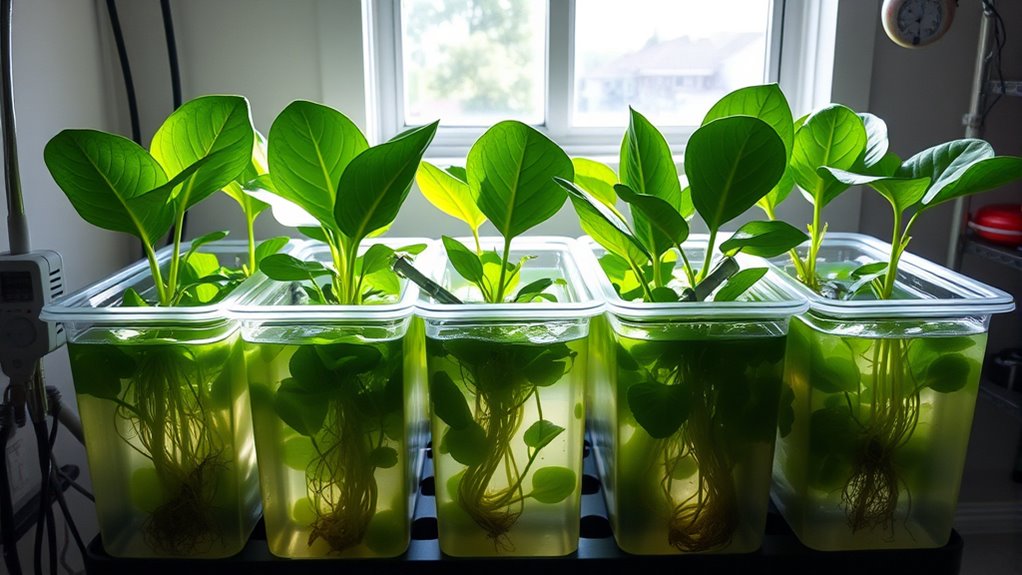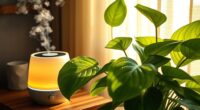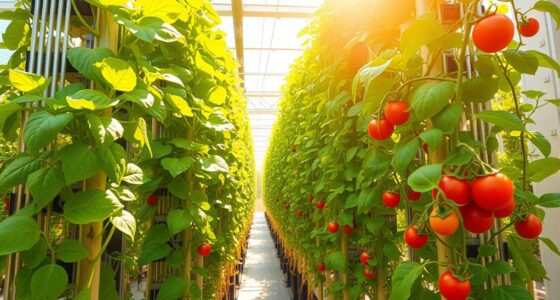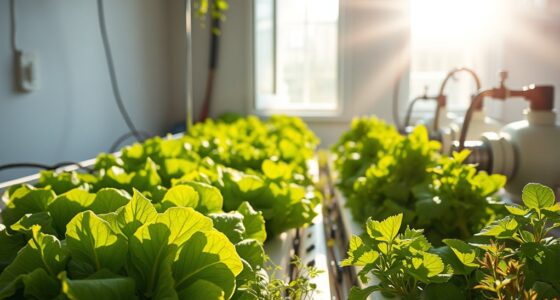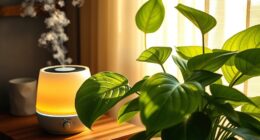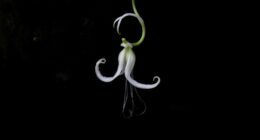If you don’t monitor pH, you’ll hide nutrient issues that stunt growth or cause plant death. Over- or under-feeding can burn roots or stall development, while poor lighting hampers photosynthesis and yields. Using bad water quality and ignoring circulation can trigger diseases. Jumping into complex systems without mastering basics leads to failures. Stay alert to these common mistakes, and you’ll find ways to improve your results. Keep going to discover how to avoid these mistakes altogether.
Key Takeaways
- Neglecting proper pH management can lead to nutrient lockout and poor plant growth.
- Over or underfeeding nutrients causes stress and reduces yields.
- Insufficient or excessive lighting hampers photosynthesis and plant development.
- Using contaminated water or poor circulation promotes root diseases.
- Lack of careful observation delays problem-solving and system adjustments.
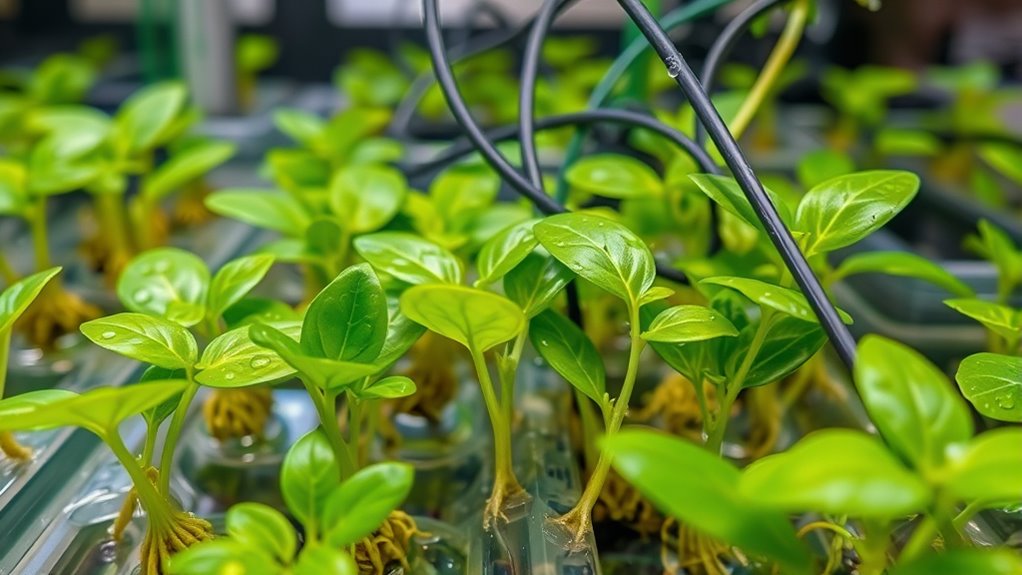
Starting hydroponics can be exciting, but beginners often make mistakes that can hinder their success. It’s easy to get carried away with the idea of growing lush plants without fully understanding the fundamentals. One common mistake is neglecting to monitor and adjust pH levels regularly. Plants in hydroponic systems rely heavily on the correct pH to absorb nutrients properly. If the pH is too high or too low, your plants can suffer from nutrient deficiencies or toxicities, leading to poor growth or even plant death. You might think your plants are healthy when they look green, but underlying nutrient imbalances can be hidden until it’s too late.
Neglecting pH monitoring in hydroponics can hide nutrient issues until it’s too late.
Another mistake many beginners make is overfeeding or underfeeding their plants. It’s tempting to think that more nutrients will lead to faster growth, but excess nutrients can cause root burn and stress your plants. Conversely, not providing enough nutrients stalls growth and weakens the plants, making them more susceptible to diseases. You need to find a balanced nutrient solution tailored to your specific plants and adjust it as they grow. Reading the instructions on your nutrients and monitoring plant responses is key to avoiding these errors.
Inadequate lighting is another common pitfall. While natural sunlight is ideal, many beginners rely solely on it without considering the intensity or duration needed for maximum growth. If your plants don’t receive enough light, they won’t photosynthesize efficiently, leading to leggy, weak stems and poor yields. On the other hand, too much direct light, especially in unprotected setups, can cause heat stress or leaf burn. Investing in proper grow lights and maintaining a consistent light schedule can make a significant difference.
Poor circulation and water quality can also tank your yields. Stagnant water promotes the growth of algae and pathogens that attack your roots. Regularly cleaning your system and ensuring good water flow keeps your plants healthy. Using filtered or clean water helps prevent the buildup of harmful minerals or contaminants that can interfere with nutrient uptake. Additionally, ignoring the importance of oxygen in your system can lead to root suffocation, so aerating your nutrient solution is essential. Incorporating proper water management practices can greatly improve plant health and yield.
Finally, rushing into complex systems without mastering basic principles can backfire. Start simple, learn how your system works, and carefully observe how your plants respond. Patience and attention to detail help you identify issues early and make corrections before they turn into costly mistakes. By avoiding these common errors, you set yourself up for a successful, rewarding hydroponic journey.
Frequently Asked Questions
Can Hydroponic Systems Be Used Indoors Year-Round?
Yes, you can use hydroponic systems indoors year-round. You just need to guarantee proper lighting, temperature, and humidity control. Invest in grow lights to mimic sunlight, maintain a stable environment, and choose plants suited for indoor growth. Regular monitoring and adjustments help prevent issues like algae or pests. With the right setup, you’ll enjoy fresh produce all year, regardless of outdoor weather conditions.
What Are the Best Beginner-Friendly Hydroponic Setups?
Imagine you’re in the age of the dinosaurs, and you want an easy start with hydroponics. The best beginner-friendly setups include deep water culture (DWC) systems and simple flood-and-drain kits. These are straightforward, affordable, and require minimal equipment. You’ll love how quickly you see results. Just keep an eye on pH and nutrient levels, and you’ll be growing healthy plants in no time.
How Do I Prevent Algae Growth in My System?
To prevent algae growth in your hydroponic system, keep the water covered or shaded to block light, which algae need to thrive. Maintain clean reservoirs by regularly removing debris and changing the water. Use algae inhibitors or hydrogen peroxide in small amounts to control growth. Also, guarantee good water circulation to prevent stagnant areas. By keeping your system dark, clean, and well-ventilated, you’ll considerably reduce algae issues.
Is It Necessary to Use Chemical Nutrients?
You don’t need to use chemical nutrients if you prefer organic options or want to keep your system natural. Many beginner growers use compost teas, fish emulsion, or other organic solutions that provide essential nutrients without chemicals. Just make certain you regularly monitor your plants and water quality, adjusting nutrient levels as needed. Natural nutrients can be just as effective, but consistency and proper measurement are key to avoiding deficiencies.
How Often Should I Change the Nutrient Solution?
You should change your nutrient solution every two to three weeks to prevent nutrient imbalance and buildup of waste. Regularly check the pH and EC levels, adjusting as needed to keep your plants healthy. If you notice sluggish growth or discoloration, it’s a good sign you need to refresh the solution sooner. Consistent maintenance ensures your hydroponic system stays ideal, maximizing your yield and plant health.
Conclusion
By steering clear of these common mistakes, you’ll navigate your hydroponic journey smoothly, like a skilled captain charting clear waters. Think of your setup as a thriving garden in a glass jar—each correct step fuels a vibrant, lush harvest waiting to burst forth. With attention and care, you’ll turn your beginner’s mistakes into stepping stones, transforming your small tank into a flourishing oasis. Keep learning, stay patient, and watch your hydroponic dreams bloom like a garden in full bloom.

